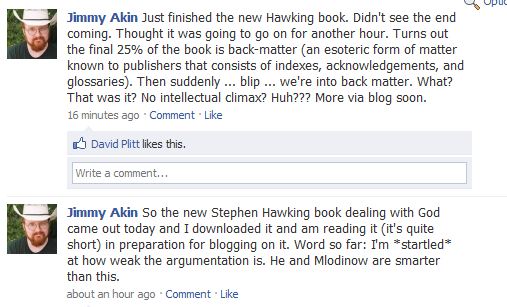 Some time ago I did a couple of posts (part I, part II) on the age of the world, in which I looked at Vatican documents dating from recent years–the Catechism of the Catholic Church and the International Theological Commission's document on our being created in the image of God.
Some time ago I did a couple of posts (part I, part II) on the age of the world, in which I looked at Vatican documents dating from recent years–the Catechism of the Catholic Church and the International Theological Commission's document on our being created in the image of God.
Both of these documents took an open stance regarding the findings of mainstream modern science concerning the age of the universe and the existence of some form of biological evolution.
They did not impose these as matters of faith, for they are not matters of faith–which was precisely the point. At present the Magisterium and related bodies like the ITC have determined that the sources of faith do not conflict with the findings of mainstream modern science on these points, and so one may follow the scientific evidence where it leads. (On other points, such as the creation of the world out of nothing and the special creation of each human soul, including those of the first humans, the faith does have something to say and the same liberty is not enjoyed.)
You might question how long the Magisterium has held this position, and that's a good question. I, for one, would love to know the answer.
Certainly, though much of Christian history a young earth view was common, though there were also voices urging that the biblical creation accounts, especially Genesis 1, should be handled with care and that they might not be the kind of chronological guide many thought. (St. Augustine, in particular, went into a great deal of depth on this point.)
It seems to me that this view is correct, that a careful reading of Genesis 1 shows that it never intended to offer a purely chronological account, and that it overtly signalled this to the original audience by placing the creation of the sun three days after the creation of the day/night cycle. People back then understood that the sun is a light, that it lights up the sky, and that it thus causes the day/night cycle.
Indeed, the ancient world was full of people whose religion was intensely bound up with this fact, such as the Egyptians, who held that the sun god Ra had to fight with the serpent monster Apophis every night so that the solar barge could return to the sky and bring daylight again. An occasional Apophis attack on Ra during the day was the explanation for eclipses and the darkness they bring. The idea was that Apophis swallowed the solar barge earlier than normal in the daily cycle, and Ra's forces were able to cut him free in a short space of time.
Genesis 1 rejects this pagan understanding of matters and simply refers to the sun as a "light." It doesn't even use the Hebrew word for "sun"–shamash–because this word as also the name of the Canaanite sun god and the author didn't want any confusion about God creating the Canaanite solar deity. So he just calls the sun a light, with the implication: "It's just a light, Don't worship it."
The point is, though, that the ancients understood the fact that the sun is the source of daylight and thus by putting the creation of the sun after the creation of the day/night cycle, the author of Genesis 1 is showing us a topically-structured rather than chronologically-structured account.
At least in my humble opinion.
For those who came from different cultural traditions, who were not as in touch with ancient Semitic ways of writing, this kind of detail could be easily missed and the whole account taken as what it superficially appeared to be–a chronologically-organized description of the creation of the world in one, seven-day week.
The need to be careful in such matters was stressed by Pius XII in his 1943 encyclical Divino Afflante Spiritu:
35. What is the literal sense of a passage is not always as obvious in the speeches and writings of the ancient authors of the East, as it is in the works of our own time. For what they wished to express is not to be determined by the rules of grammar and philology alone, nor solely by the context; the interpreter must, as it were, go back wholly in spirit to those remote centuries of the East and with the aid of history, archaeology, ethnology, and other sciences, accurately determine what modes of writing, so to speak, the authors of that ancient period would be likely to use, and in fact did use.
36. For the ancient peoples of the East, in order to express their ideas, did not always employ those forms or kinds of speech which we use today; but rather those used by the men of their times and countries. What those exactly were the commentator cannot determine as it were in advance, but only after a careful examination of the ancient literature of the East. The investigation, carried out, on this point, during the past forty or fifty years with greater care and diligence than ever before, has more clearly shown what forms of expression were used in those far off times, whether in poetic description or in the formulation of laws and rules of life or in recording the facts and events of history.
A bit earlier in the same encyclical, Pius XII notes some of the historical difficulties in interpreting the early chapters of Genesis:
31. Moreover we may rightly and deservedly hope that our time also can contribute something towards the deeper and more accurate interpretation of Sacred Scripture. For not a few things, especially in matters pertaining to history, were scarcely at all or not fully explained by the commentators of past ages, since they lacked almost all the information which was needed for their clearer exposition. How difficult for the Fathers themselves, and indeed well nigh unintelligible, were certain passages is shown, among other things, by the oft-repeated efforts of many of them to explain the first chapters of Genesis; likewise by the reiterated attempts of St. Jerome so to translate the Psalms that the literal sense, that, namely, which is expressed by the words themselves, might be clearly revealed.
A few years later, in his 1950 encyclical Humani Generis, which deals with biological evolution, he also commented on the literary character of the early chapters of Genesis in a way that anticipates the approach taken by the Catechism:
38. . . . the first eleven chapters of Genesis, although properly speaking not conforming to the historical method used by the best Greek and Latin writers or by competent authors of our time, do nevertheless pertain to history in a true sense, which howevermust be further studied and determined by exegetes; the same chapters . . . in simple and metaphorical language adapted to the mentality of a people but little cultured, both state the principal truths which are fundamental for our salvation, and also give apopular description of the origin of the human race and the chosen people. If, however, the ancient sacred writers have taken anything from popular narrations (and this may be conceded), it must never be forgotten that they did so with the help of divine inspiration, through which they were rendered immune from any error in selecting and evaluating those documents.
Now, I don't quote these passages from Pius XII as having a great deal of bearing on the age of the universe. They are illustrative of the Magisterium's attitude toward the early portions of Genesis.
So what does Pius XII say on the age of the world from a scientific perspective?
This is found in a speech he gave in 1951 to the Pontifical Academy of the Sciences. In it, he says [My comments added in red–JA]:
35. First of all, to quote some figures–which aim at nothing else than to give an order of magnitude fixing the dawn of our universe [so he's not signing off on any specific date], that is to say, to its beginning in time–science has at its disposal various means, each of which is more or less independent from the other, although all converge. We point them out briefly [Note that in what follows Pius XII mixes evidences regarding the dates for the origin of the universe and the origin of the solar system, both of this he is evincing regarding "the dawn of our universe." He does not clearly distinguish between the two–a conflation which may have been common at the time. This conflation is in part responsible for the range of dates he considers.]:
(1) recession of the spiral nebulae or galaxies:
36. The examination of various spiral nebulae [i.e., galaxies], especially as carried out by Edwin W. Hubble at the Mount Wilson Observatory, has led to the significant conclusion, presented with all due reservations [so even the scientists are being tentative about this and the Church isn't signing off on it as a certainty or an article of faith], that these distant systems of galaxies tend to move away from one another with such velocity that, in the space of 1,300 million years, the distance between such spiral nebulae is doubled. If we look back into the past at the time required for this process of the "expanding universe," it follows that, from one to ten billion years ago, the matter of the spiral nebulae was compressed into a relatively restricted space, at the time the cosmic processes had their beginning. [Ten billion is a little on the small side, viewed by 2010 mainstream science; 13-14 billion is the common estimate today, though this doesn't matter since Pius XII is only aiming for an order of magnitude.]
(2) The age of the solid crust of the earth:
37. To calculate the age of original radioactive substances, very approximate data are taken from the transformation of the isotope of uranium 238 into an isotope of lead (RaG), or of an isotope of uranium 235 into actinium D (AcD), and of the isotope of thorium 232 into thorium D (ThD). The mass of helium thereby formed can serve as a means of control. This leads to the conclusion that the average age of the oldest minerals is at the most five billion years. [This agrees with the common age held for the formation of the earth and the solar system: 4.6 billion year.]
(3) The age of meteorites:
38. The preceding method adopted to determine the age of meteorites has led to practically the same figure of five billion years. [Meteorites, as part of the solar system, ditto.] This is a result which acquires special importance by reason of the fact that the meteorites come from outside our earth and, apart from the terrestrial minerals are the only examples of celestial bodies which can be studied in scientific laboratories. [This was, of course, before we went to the moon and started bringing back samples from there and–robotically–from elsewhere in the solar system.]
(4) The stability of the systems of double stars and starry masses:
39. The oscillations of gravitation between these systems, as also the attrition resulting from tides, again limit their stability within a period of from five to ten billion years.
40. Although these figures may seem astounding, nevertheless, even to the simplest of the faithful, they bring no new or different concept from the one they learned in the opening words of Genesis: "In the beginning . . .," that is to say; at the beginning of things in time. The figures We have quoted clothe these words in a concrete and almost mathematical expression, while from them there springs forth a new source of consolation for those who share the esteem of the Apostle for that divinely inspired Scripture which is always useful "for teaching, for reproving, for correcting, for instructing" (2 Tim., 3, 16).
E. THE STATE AND QUALITY OF ORIGINAL MATTER
41. [In this section, the pontiff again seems to conflate the origin of the universe with later events–the later events in this case being the creation of heavy elements. This may be because the concept of stellar nucleosynthesis–the creation of heavier elements in stars rather than in the Big Bang–was a new concept in his day that had just been proposed and was still being worked out.] In addition to the question of the age of the cosmos, scholars have, with similar earnestness and liberty of research and verification, turned their daring genius to the other problem which has already been mentioned and which is certainly more difficult, concerning the state and quality of primitive matter. [Here he seems to mean the matter at the beginning of the universe, at or just after the Big Bang.]
42. According to the theories serving as their basis, the relative calculations differ in no small degree from one another. Nevertheless, scientists agree in holding that not only the mass but also the density, pressure, and temperature of matter must have reached absolutely enormous proportions as can be seen from the recent work of A. Unsold [Albrecht Unsold], director of the Observatory of Kiel (Kernphysik und Kosmologie ["Nuclear Physics and Cosmology"–see a short English language abstract of the paper via Google Bookshere.], in the Zeitschrift fur Astrophysik, 24, B. 1948, pag. 278-306). Only under such conditions can we explain the formation of heavy nuclei and their relative frequency in the periodic system of the elements. [Perhaps at the time this was the only way they could see such elements being formed; later thought–and according to a recently proposed theory by Hubble at the time–the pressures and densities found in the life cycle of certain stars will do the trick just fine. This is now the received view.]
43. Rightly, on the other hand, does the mind in its eagerness for truth insist on asking how matter reached this state, which is so unlike anything found in our own everyday experience, and it also wants to know what went before it. In vain would we seek an answer in natural science, which declares honestly that it finds itself face to face with an insoluble enigma. [Both of the preceding sentences seem to confirm that he is thinking about the Big Bang and the state of matter in it.] It is true that such a question would demand too much of natural science as such. But it is also certain that the human mind trained in philosophical meditation penetrates more deeply into this problem.
44. [Now Pius XII begins to meditate on the religious implications of the foregoing.] It is undeniable that when a mind enlightened and enriched with modern scientific knowledge weighs this problem calmly, it feels drawn to break through the circle of completely independent or autochthonous [i.e., native, indigenous] matter, whether uncreated or self-created, and to ascend to a creating Spirit. With the same clear and critical look with which it examines and passes judgment on facts, it perceives and recognizes the work of creative omnipotence, whose power, set in motion by the mighty "Fiat" pronounced billions of years ago by the Creating Spirit, spread out over the universe, calling into existence with a gesture of generous love matter bursting with energy. In fact, it would seem that present-day science, with one sweeping step back across millions of centuries, has succeeded in bearing witness to that primordial "Fiat lux" ["Let there be Light"] uttered at the moment when, along with matter, there burst forth from nothing a sea of light and radiation, while the particles of chemical elements split and formed into millions of galaxies. [Note the quickness to associate the creation of light with the Big Bang; though this can be done in a literary or poetic way, one must be cautious not to take it too literally; see the link in the next paragraph.]
45. It is quite true that the facts established up to the present time are not an absolute proof of creation in time [VERY important point, as written about before; good to see the point being made in this context!], as are the proofs drawn from metaphysics and Revelation in what concerns simple creation or those founded on Revelation if there be question of creation in time. The pertinent facts of the natural sciences, to which We have referred, are awaiting still further research and confirmation, and the theories founded on them are in need of further development and proof before they can provide a sure foundation for arguments which, of themselves, are outside the proper sphere of the natural sciences. [This theme very much taken up in later documents: Science can take us to a certain point but not farther.]
46. [Now the pontiff comments on what an earthquake the Big Bang turned out to be for the previously accepted view in mainstream science.] This notwithstanding, it is worthy of note that modern scholars in these fields regard the idea of the creation of the universe as entirely compatible with their scientific conceptions and that they are even led spontaneously to this conclusion by their scientific research. Just a few decades ago, any such "hypothesis" was rejected as entirely irreconcilable with the present state of science.
47. As late as 1911, the celebrated physicist Svante Arhenius declared that "the opinion that something can come from nothing is at variance with the present-day state of science, according to which matter is immutable." (Die Vorstellung vom Weltgebaude im Wandel der Zeiten, 1911, pag. 362). In this same vein we find the statement of Plato: "Matter exists. Nothing can come from nothing, hence matter is eternal. We cannot admit the creation of matter." (Ultramontane Weltanschauung und Moderne Lebenskunde, 1907, pag. 55).
48. On the other hand, how different and much more faithful a reflection of limitless visions is the language of an outstanding modern scientist, Sir Edmund Whittaker, member of the Pontifical Academy of Science, when he speaks of the above-mentioned inquiries into the age of the world: "These different calculations point to the conclusion that there was a time, some nine or ten billion years ago, prior to which the cosmos, if it existed, existed in a form totally different from anything we know, and this form constitutes the very last limit of science. We refer to it perhaps not improperly as creation. It provides a unifying background, suggested by geological evidence, for that explanation of the world according to which every organism existing on the earth had a beginning in time. Were this conclusion to be confirmed by future research, it might well be considered as the most outstanding discovery of our times, since it represents a fundamental change in the scientific conception of the universe, similar to the one brought about four centuries ago by Copernicus." (Space and Spirit, 1946, pag. 118- 119).
Conclusion:
49. What, then, is the importance of modern science for the argument for the existence of God based on the mutability of the cosmos? By means of exact and detailed research into the macrocosm and the microcosm, it has considerably broadened and deepened the empirical foundation on which this argument rests, and from which it concludes to the existence of an Ens a se [i.e., a being not contingent on another], immutable by His very nature.
50. It has, besides, followed the course and the direction of cosmic developments, and, just as it was able to get a glimpse of the term toward which these developments were inexorably leading, so also has it pointed to their beginning in time some five billion years ago. Thus, with that concreteness which is characteristic of physical proofs, it has confirmed the contingency of the universe and also the well-founded deduction as to the epoch when the cosmos came forth from the hands of the Creator.
51. Hence, creation took place in time. Therefore, there is a Creator. Therefore, God exists! Although it is neither explicit nor complete, this is the reply we were awaiting from science, and which the present human generation is awaiting from it.
The takeaway message from this is that the Magisterium's openness to the idea that the universe is billions of years old is not some new, sinister, modernist, post-Vatican II thing. It was accepted–enthusiastically–by Pope Pius XII–the pope who defined the Assumption of Mary and, incidentally, just the year after he defined it.
He also used the finding of Big Bang cosmology and Old Earth science to buttress the idea of the existence of God, while noting a number of important caveats that this reasoning from science cannot be taken as definitive.
 I’ve read a number of books by Stephen Hawking (pictured) and Leonard Mlodinow, writing both together and separately. I’ve enjoyed them. They’re informative and funny, and they make clear some pretty deep concepts of physics and mathematics—without burdening you with a bunch of equations (that’s some trick).
I’ve read a number of books by Stephen Hawking (pictured) and Leonard Mlodinow, writing both together and separately. I’ve enjoyed them. They’re informative and funny, and they make clear some pretty deep concepts of physics and mathematics—without burdening you with a bunch of equations (that’s some trick).







